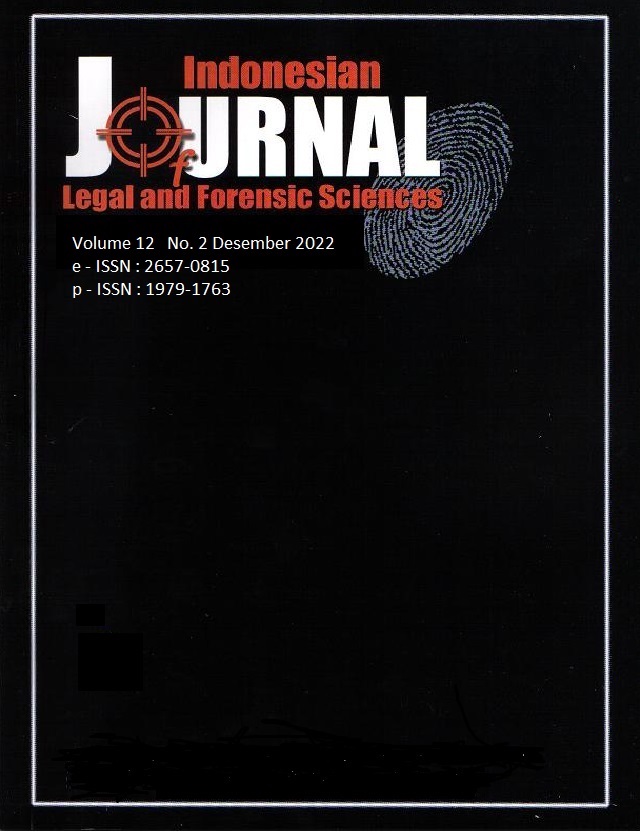Variasi Pola Trauma pada Kasus Kematian Akibat Tindak Kekerasan Berdasarkan Data Autopsi di Instalasi Forensik RSUD Dr. Doris Sylvanus Tahun 2016 – 2020
Abstract
Based on BPS data, the crime rate in Indonesia from 2015 – 2019 tends to decrease, But Central Kalimantan province, which is one of the provinces with the lowest population, has a high crime rate that causes death, which is 12th nationally. The aim of this research is to describe the age, gender, any type of trauma, and the location of the most common injuries on the bodies that were carried out for forensic autopsies at RSUD dr. Doris Sylvanus in 2016 – 2020. This research was a descriptive observational study with approach cross sectional (cross-sectional). From a population of 150 corpse data, 68 corpse data were obtained that met the inclusion criteria. The majority of the victims were male 53 data (81.54%). The majority of victims are adults with 66 (97.06%) bodies. Sharp trauma was the most common with 33 (48.53%) bodies followed by blunt trauma as many as 29 (42.65%) bodies. The head is the most traumatized body part, namely 27 (39.71%) bodies. Most of the sharp and blunt traumas are because the tools used are easy to get and close to everyday life. Men are involved in many murder cases because the men themselves are often involved in violence due to the influence of the hormone testosterone. Adults are mostly involved with violence because at that age they are filled with various problems such as emotional tension, increased responsibility, and so on.
Downloads
References
[2] [BPS] Badan Pusat Statistik. Berita resmi statistik [Internet]. Bps.Go.Id. 2019. [Dikunjungi pada Kamis, 17 Juni 2021] Tersedia di: https://papua.bps.go.id/pressrelease/2018/05/07/336/indeks-pembangunan-manusia-provinsi-papua-tahun-2017.html
[3] [BPS] Badan Pusat Statistik. Statistik Kriminal 2020. Subdirektorat Statistik Politik dan Keamanan, editor. Jakarta: BPS RI; 2020. 10–14 p.
[4] Rahmawati R, Suparmono D. Kajian Sosio-Biologi Minuman Baram Masyarakat Dayak Wilayah Katingan Kalimantan Tengah. Anterior J. 2014;14(1):101–9.
[5] Aflanie I, Nirmalasari N, Arizal MH. Ilmu Kedokteran Forensik & Medikolegal. Depok: PT RajaGrafindo Persada; 2017. 91–255 p.
[6] Batrinos ML. Testosterone and aggressive behavior in man. Int J Endocrinol Metab. 2012;10(3):563–8.
[7] Susantyo B. MEMAHAMI PERILAKU AGRESIF: Sebuah Tinjauan Konseptual. Sosio Inf. 2011;16(3):189–202.
[8] Novela Sari S. Faktor-Faktor Yang Mempengaruhi Tindakan Kriminal Di Kota Surabaya Tahun 2016 Dengan Metode Regresi Logistik Multinomial. Institut Teknologi Sepuluh Nopember; 2017.
[9] Thahir A. Psikologi Kriminal. Bandar Lampung; 2016. 27–59 p.
[10] Yulianti Ricky Dany KAW .Karakteristik Sebab Dan Mekanisme Kematian Pada Korban Yang Diduga Dibunuh Yang Diotopsi Di Instalasi Kedokteran Forensik Rsup Sanglah Tahun 2011-2012. E-Jurnal Med Udayana [Internet]. 2014;3(5):561–72. [Dikunjungi pada Sabtu, 30 Oktober 2021] Tersedia di :https://ojs.unud.ac.id/index.php/eum/article/view/8859/6644
[11] Karwur B, Siwu J, Mallo JF. Pola Luka pada Korban Meninggal akibat Kekerasan Tajam yang Diautopsi di RSUP Prof. Dr. R. D. Kandou Tahun 2014. Med Scope J. 2019;1(1):39–43.



















